Southport Village Voices
An E-Magazine by & for the Residents of Southport
Number 71, January 2016
|
|
|
|
|
|
|
|
How Did You Meet Your Mate?
|
It's always intriguing to learn how two people met -- and liked each other well enough to think about spending the rest of their lives together.
In observance of Valentine's Day, I'd like to invite a few brave Southporters to share their "how we met" stories in the February issue of SVV.
Was your meeting romantic, awkward, funny, sweet? Was it a blind date, an introduction by a friend, or just random. Was it love at first sight? Who made the first move?
I don't need a lot of words -- 300 or less would be good, and I'd need your story by January 22 -- by email since I'm in Hawaii. If you have a digital picture to go with the story, that's even better.
C'mon. Let's have a little fun with this!
-------------------------------------------
We're always looking for new Southport Village "Voices." If you have a story, an essay, a review, a poem, a memory, a photo or painting, etc. to share, please send it along. Any number can play.
|
|
 |
|
|
|
SOUTHPORT PROFILE
Ed Larkin: Civic Activist
by Arthur Wagman
|
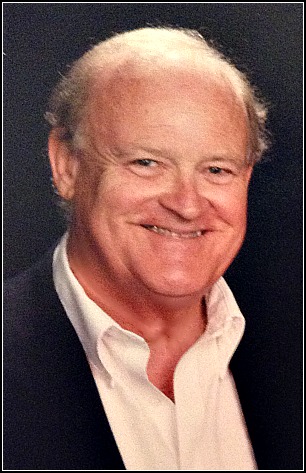 Ed Larkin has never been one to shy away from public service. Southport residents may know him as a member of Southport's original Board of Governors, but every time they look across Old Barnstable Road at the beautiful facility known as the Bridges, they should also know that Ed was instrumental in having that site developed in a way that protected Southport's interests and values. Ed Larkin has never been one to shy away from public service. Southport residents may know him as a member of Southport's original Board of Governors, but every time they look across Old Barnstable Road at the beautiful facility known as the Bridges, they should also know that Ed was instrumental in having that site developed in a way that protected Southport's interests and values.
Perhaps, as in all cases, it is best to begin at the beginning. Ed was born in Medford, Massachusetts, grew up there and graduated from Medford High School before going on to Northeastern University where he graduated with a degree in business administration in 1957. Following a brief tour in the Army, Ed returned to civilian life and worked at various jobs before realizing that he had a knack for sales, ultimately ending up in the casket business or, as Ed is fond of saying, "selling underground furniture." Ed met his future wife Vye at a night club in Boston and they married in 1959. At the time, Vye was working for the Army Corps of Engineers in Boston and Ed had just started his job. They had three children and were married for 52 years
Wherever the Larkins made their home they became active members of and participants in the community. After living briefly in Springfield and Worcester, they moved to Dedham in 1964. Vye participated in numerous local clubs and activities while Ed became involved in activities such as Little League, where he became director, and Rotary. But his primary interest was in town politics; he became chair of the Dedham Charter Commission, which created a new town charter that was adopted in 1974. He was elected to the Dedham Board of Selectman in 1976.
Ed and Vye remained very active in the Dedham community until they moved to Southport in 1999, as two of the original Southport "pioneers." Ed recalls, "The kids had grown up and moved on and we realized the Dedham house was too big, so we sold it and moved to the Cape. We had relatives in Sandwich and bought a condo there. We heard about Southport from Ann and Frank Antonelli, whom we had known in Dedham, and we found Southport was a perfect fit for us. We immediately sold the Sandwich condo and bought in Southport."
|
| |
Ed & Vi with their children in earlier days.
|
At Southport the Larkins continued to be involved in community affairs. Vye founded Southport's traditional Angel Tree campaign for needy children and families, became a member of the Mashpee Women's Club and an active participant in Christ the King Parish and various other activities.
Ed followed his interests into municipal affairs, joining the Mashpee Community Preservation Committee and becoming chair of Mashpee's Charter Commission, helping to develop the Mashpee town charter that was adopted in 2004. He is also Mashpee's assistant town moderator whose job is to stand by and, as Ed puts it, "If the moderator faints I take over and allow the town meeting to continue." But, he admits, that has yet to happen. He was also instrumental in founding the Southport Scholarship Committee that, each year, holds the Pastabilities scholarship dinner to raise funds for deserving Mashpee High School students who plan to attend college.
In 2002 Ed led the opposition to the building of a drive-thru Burger King on the 27-acre tract where Bridges now sits, ultimately causing Burger King to back away from the project. Mindful of the fact that the welfare of Southport requires monitoring the legislative affairs of town and state governments, Ed, along with Al Benjamin and Eda Stepper, formed the Southport Legislative Committee. In 2003 the committee, with Ed as chair, citing the noise, traffic, light pollution and accompanying refuse, was the driving force in defeating a proposal to build a large Shaw's supermarket on the same site.
And at the Mashpee Town Meeting in October 2008, the Southport Legislative Committee, again led by Ed Larkin, gathered enough votes to defeat a proposal to change the zoning of the parcel. That change would have enabled a developer to build a proposed 233-unit independent living complex, consisting of four separate buildings each approximately four stories high, and totaling 330,482 sq.ft. It was not until 2012 that a developer approached the town with the proposal for the Bridges. This project utilized only five acres for construction, proposed building a much smaller, one story facility and set aside the remaining land for conservation in perpetuity. It was the perfect project for the location and with Ed's encouragement Southport supported the project.
Sadly, Vye passed away in 2012 and their daughter Debbie passed away last year. Ed admits it is difficult being on one's own after so many years and the grief of losing a child is unimaginable. He continues to work, making sales calls and trying to "stay as busy as possible," calling on many of the accounts he has serviced for over five decades. "Life is not easy," he concedes.
All of us should give an appreciative nod and say a heartfelt 'thank you' to a resident who in so many ways has made so many positive contributions to Southport.
|
Full
by Lydia Biersteker
|
It makes me crazy
to hear someone say,
"My other half," or
"My better half."
I'm not a half of anything.
I'm a complete entity,
a whole person,
a woman sated
and brimming,
choosing to share my life
with an equal.
Together we are better,
or we're double-trouble,
depending on your perspective
of your own self worth.
|
|
MEMOIR
The Bow-Runner Sled
by Roy Smith
|
Winter months in the 1940s, in our New England village, are remembered as cold, wet and very snowy. Runny noses, heavy clothing, the smell of hot wool from the kitchen radiator piled with drying mittens and hats, Mother's beef stew and hot gingerbread stand out in my mind. Indoors there were board games of every kind to occupy our spare time, Lincoln Logs, Tinker Toys, and if one were really lucky, an Erector Set. All were well used, often handed down from older siblings or friends. There were also books, wonderful books that were read and reread quietly on an inclement day as one curled up in the old leather rocking chair next to that giant steam radiator in the kitchen.
Many of the larger playthings enjoyed by my sister and me were handmade or used, often given to my father by clients in the city. They were occasionally broken and he would repair and refinish them good as new for our use. One item that we were very proud of and used whenever there was enough snow was a very old bow-runner sled. It was about 3 1/2 feet long, 12 or so inches wide, about 10 inches off the ground and with slightly splayed hardwood runners ending in a graceful, upward bend at the front curling back in a small loop. It was just flexible enough to permit minimal steering. A metal band ran along the bottom of each hard-wood runner. My father outdid himself on this little antique and it was a beautifully varnished, stenciled eye catcher.
 There weren't many large hills in our village, so when it snowed the few available for sledding were well used by children. It didn't matter that they were on private property; we just gravitated to them and were rarely chased off. I was fortunate because Mahoney's Hill, at the end of the short road that passed by my home, was one of the best. There weren't many large hills in our village, so when it snowed the few available for sledding were well used by children. It didn't matter that they were on private property; we just gravitated to them and were rarely chased off. I was fortunate because Mahoney's Hill, at the end of the short road that passed by my home, was one of the best.
The Mahoneys were an older couple who lived in a large, well-kept Victorian house with a detached barn that once had housed a horse and still contained a dusty old horse carriage and garden tools. Overhead, a small hayloft was filled with items left over from an earlier time. (I know because I checked it out while on assignment looking for their lost cat.) The property was surrounded by small fields now mostly overgrown with brush and small trees. To the right of the house, a hay field sloped down in a long, easy hill to a growth of tall weeds and brush with woodland beyond. It was a perfect hill for sledding, and the small gang of neighborhood kids waited each winter for a snowfall and a chance to use Mahoney's Hill. The Mahoneys rarely appeared while we were sledding but sometimes watched and waved from a big bay window during a particularly busy sledding session.
From the base of the hill, small mounds could be seen pushing up snow where tufts of last summer's uncut hay lay underneath. Sledding could be quite exciting when our sleds flew over these mounds. At the bottom one would run into and over the undergrowth at the edge of the woods that protected us from the larger trees beyond. Crashing into this miniature forest was grand fun when it was all covered in the sparkling, powdery fluff of a new snow.
We gathered at the top waiting, sometimes not, for a turn with a variety of sleds. A few were new with all metal runners, some homemade with wood runners and impossible to steer, and an occasional apple box mounted on a couple of barrel staves, anything to make that wild run downhill. We gave our handsome little bow-runner sled a workout. With its tough elm wood frame, it was as light as a feather and flew over the snow. There were only a few squabbles with other kids demanding that we share. With this particular item I am afraid that we were quite possessive.
We returned home cold, tired and wet but happy at the end of a winter day. Coasting on Mahoney's Hill was great fun and we kept at it until the snow cover was worn away or destroyed by rain. Luxuries were few but we certainly enjoyed what we had. It was a time in our lives when we anticipated winter's snow with pleasure instead of a chore.
|
|
NON COMPOS MENDES
Bob Mendes
|
- Are we living in Fat City or what? In last month's column I solicited any New Year's resolutions Southport residents may have made. Every one of those that I received -- except one -- said the same thing: "I'm going to lose some weight." (The amounts mentioned varied greatly.) The only response that differed was from my friend Mike Cowley who feels his weight is OK, but he's concentrating on growing taller.
- Sometimes you're smart. Other times not so much. Last month my frozen brain attributed My Fair Lady to Rodgers and Hammerstein. Mea culpa, it was created by Lerner & Loewe. I'm grateful to my friend Joe Tinlin for reminding me how stupid I am.
- What would a January first column be without a prediction? Here's mine: Some lucky Southport resident will be traveling on Leisure Green at the corner of Pine Hill and will hit a pothole deep enough to strike oil.
- I'm glad I don't live in Iowa. Those folks have a tough decision coming up. I can't decide who scares me more, Donald Trump or Ted Cruz.
- I often take my grand-dog Ginger (she loves to see her name in print) to the high school athletic field for a run and Frisbee chase. Last trip there I noticed the volleyball net was in shreds and remembered that last fall I had wondered why they didn't take it down for the winter. My point is that our tennis nets and windscreen are still standing, and their fate will be that of the high school volleyball net if they remain all winter, an avoidable expense. Somebody?
- If you're ever hyped up and looking for something to calm you down, take a look through PARADE Magazine. I hadn't seen one in about 30 years and forgot how boring and uninformative it was. The mystery: How does it stay in business?
- You can't make these things up. Recently, while going through some old notes I had made on various subjects, I noticed one that took up 899 pages. It was a report concluding that smoking is unhealthy.
- Is doctor a dirty word? Lately the media have been referring to "health care providers" instead of the word doctor. Another example of political correctness run rampant.
- FINAL THOUGHT If you think the current primary campaign is a joke, take a look at some past campaigns (from "Anything for a Vote," a book I acquired from my son through devious means.)
1872 U.S. Grant vs. Horace Greeley
Boss Tweed wrote, "I did not suppose that any men outside of a lunatic asylum would nominate Greeley for President." A reporter wrote that Greeley's nomination had to be the result of not enough whiskey at the Cincinnati convention. By this time Greeley was cooked.
1920 Warren G. Harding vs. James Cox
The Republicans's biggest challenge was to hide the bodies, literally. Harding had so many affairs in his background that they kept popping up at inopportune times. Fortunately for Harding, there were no TV debates in those days, so Cox never had the opportunity to publicly confront him on his infidelities (not to mention his drinking and wild parties). After listening to one of Harding's meandering speeches, H.L. Mencken wrote, "It reminds me of wet sponges on a line drying."
1928 Herbert Hoover vs. Al Smith
America's first Catholic presidential candidate didn't have a chance. Shortly after his nomination a newspaper headline read: "Rome suggests Pope move here." At the time of the election, New York's Holland Tunnel was under construction. Republicans circulated pics of Smith at the mouth of the tunnel and asserted that it really led under the Atlantic, straight to the Vatican basement.
|
|
HISTORY
A Massachusetts Portrait
Benjamin Butler: "Beast" or Populist?
by Tom Kelleher
|
|
| |
Benjamin Butler in his Union Army uniform
by Brady-Handy, 1862-1864
|
Benjamin F. Butler (1818-1893) was viewed by many as a rogue, while others saw him as a champion of the poor and downtrodden. Evidence abounds to support both characterizations.
Butler grew up in Lowell, MA, where his mother worked in the textile mills. He graduated from Waterville College (now Colby) and later married into Lowell's wealthy Hildreth family. His talents manifested themselves early. He became a brilliant lawyer and a successful businessman as a principal shareholder in Lowell's Middlesex Mills.
He also had an amazing political and military career, including stints as a state representative and state senator in the 1850s, two terms as a US Congressman, and a term as Massachusetts' governor in 1882. During the Civil War, he attained the rank of Major General and was considered as a vice presidential running mate by Abraham Lincoln in 1864; he was even a candidate for President in 1884. Despite his impressive achievements, controversy and suspicion followed Butler at every turn. Perhaps his own self-serving and often contradictory actions did little to minimize these troubles.
Butler had a penchant for taking on both sides of an issue. As a lawyer he often represented the working poor, yet many of his clients were mill owners. As a politician he supported the 10-hour day for mill workers, but railed against labor strikes. He changed political parties as a matter of expediency. As a Democrat, he supported the party's pro-slavery stand, but as the nation drifted toward Civil War, he became an ardent Republican and abolitionist. As a Union General, Butler won fame by declaring runaway slaves who crossed Union lines as "contraband," allowing them to remain free and to join Union forces (and paving the way for Lincoln's Emancipation Proclamation). As a US Congressman, Butler co-authored anti-Ku Klux Klan legislation and helped sponsor the first Civil Rights Act of 1875. As a member of the Radical Republicans in Congress, he was chief prosecutor in the impeachment trial of President Andrew Johnson who, as a southerner and former slave holder, was viewed as too lenient on the former Confederacy.
It was as Military Governor of New Orleans, however, that Butler earned his lasting reputation as "Beast Butler." The city was captured by Union Forces early in the Civil War and Butler was put in charge. Ruling with an iron fist, he censored the press, suppressed unrest and earned the undying hatred of its citizenry. Butler's contradictory nature was revealed once again when a mob raided a Union occupied building and tore down the American flag. After the mob's leader was tried and ordered hung, Butler refused to pardon the man despite pleas for mercy from the condemned man's wife and children. However, he later assumed responsibility for the widow by paying off her debts and finding her employment in Washington, DC.
|
| |
General Butler earned the hatred of the citizens of New Orleans, and his nickname, The Beast, when he insulted the flower of Southern femininity.
|
Butler finally went too far. When occupying Union troops were insulted, spit upon and subjected to "chamber pot attacks" from women of New Orleans's social elite, Butler took an action that caused an uproar not only in the South and North, but throughout Europe as well. He issued his notorious General Order No. 28, declaring that any woman who insulted Union forces or violated curfews was to be treated like a common lady of the night "plying her trade," i.e., a prostitute. The insults hurled at Union troops stopped but not before Butler had earned the label that has stuck with him: "Beast Butler." For this egregious slight to the honor and virtue of Southern women, Confederate President Jefferson Davis declared Butler an outlaw and ordered that, if captured, he was to be executed.
Additional criticisms were leveled at Butler. He was accused of stealing the possessions of those seeking safe havens outside Union lines. He supposedly kept a set of silverware taken from a woman who, fleeing the Union occupation, was allowed to take personal clothing only. This alleged action earned Butler another derisive sobriquet: "Spoons Butler." Butler was also suspected of engaging in illicit trade with southern businessmen and brokers. His brother and brother-in-law acted as his fiscal agents in New Orleans and were known to participate in questionable financial dealings with the enemy (perhaps while he looked the other way). However, no specific evidence has ever been produced linking Butler to these profiteering schemes.
Butler's military career itself was a contradiction. Although he had little military training, he used his business and political ties to be commissioned as a Brigadier General and won command of the Massachusetts 6th and 8th Volunteer Regiments (probably with a promise to Governor Andrew to outfit the troops with uniforms made from cloth produced at his own Middlesex Mills in Lowell). By luck, Butler's troops did help secure Baltimore, thus preventing Maryland from joining the Confederacy and saving Washington from being surrounded by hostile forces (and earning Butler, with President Lincoln's approval, his promotion to Major General).
|
| |
Butler retired to a career in Massachusetts politics and a summer home in Gloucester, where this portrait was painted by A. J. Wiggin. Courtesy of the Cape Ann Museum
|
Yet, in spite of these initial impressive military actions, Butler was responsible for a number of later military failures and, with General Grant's approval, was relieved of his command in 1865 and sent home to Lowell, where he resigned his commission and resumed his political career. He died in Washington, DC and is buried in the Hildreth Family Cemetery in Lowell. So, was Benjamin F. Butler a rogue or a statesman? A hero or a villain? A humanitarian or an unfeeling, self-aggrandizing tyrant?
That's for you to decide.
SOURCES
|
|
Cottage at Ballston Beach
by Rosanne Francesconi
| |
|
FAMILY
Grandpa's Specialty:
Ham and Egg Breakfast Sandwiches
by Ray Schumack
|
If you grew up with loving grandparents in your life you were lucky and will forever have happy memories of them.
When I was born, my parents and sister were living rent free in the second floor apartment of a home owned by my mother's parents on Virginia Avenue in the East Bronx, a neighborhood shared peacefully by Irish, Italian and Jewish families.
There are early memories of my grandmother wearing an apron, in the kitchen making an apple pie. Unfortunately she died early on so my memories are mostly about a doting grandfather, Frederick Thomas Mooney. As a young man, Fred was a mason who helped build the stone towers of the Brooklyn Bridge, the world's first suspension bridge. But that's another story.
My earliest recollection of Grandpa was during the Great Depression. Our family had moved to an apartment in the West Bronx so Grandpa could collect rent from his second floor apartment to help cover his mortgage payments. At that time, he was working as a night watchman in a local factory but eventually he lost that job. Once my father got a steady, good paying job with the City of New York, he could help with the mortgage, so we moved back to Grandpa's house. This time we were all together on the first floor with Grandpa and his unemployed bachelor son Ralph. This was a crowded house; especially since Grandpa had a Boston terrier, Uncle Ralph brought home a Scottie, and the upstairs tenants had a Labrador retriever.
Grandpa took it upon himself to keep me entertained. We did everything together -- saving old newspapers, for instance, tied up in bundles to sell for a few pennies a pound to a junk man who showed up in front of the house now and then in a horse-drawn wagon. Grandpa once gave me 65 cents from the sale of a huge newspaper bundle. In the 1930s that was like making $10! A side benefit of these transactions was that the horse sometimes left a load of manure in the street, which Grandpa collected with a pail and shovel to fertilize his radishes growing in the back yard.
Grandpa always made breakfast for me. He did this while wearing his undershirt, keeping his dress shirt clean in case he had to go out for a job interview. His specialty was a unique ham and egg breakfast sandwich. Today you can get an ordinary ham and egg sandwich at Dunkin' Donuts, Burger King, McDonalds and even many neighborhood delis. Grandpa's was different. He fried a slice of boiled ham slightly, added an egg, broke the yolk, flipped the egg and cooked it just enough so the yolk would not run completely out of the sandwich. He placed the ham and egg on a slice of bread and added the final touches -- salt and pepper, several dabs of ketchup, a few squirts of Worcestershire sauce and a cover slice of bread. You might not like any one of these ingredients but when put all together, something wonderful happens.
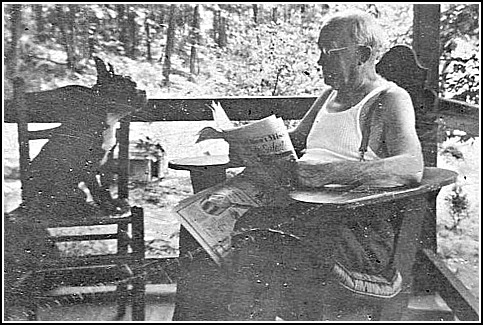
This morning I made one of Grandpa's sandwiches. As usual, it reminded me of him so I decided to tell you about it. I took this picture with my Kodak box camera in the late 1930s on the porch of the summer home my dad built. That's "Patsy" on the chair across from Grandpa.
|
|
New in the Neighborhood
Snapshot Interviews and Photos
by Andy Jablon
|
Jules & Faith Weiss 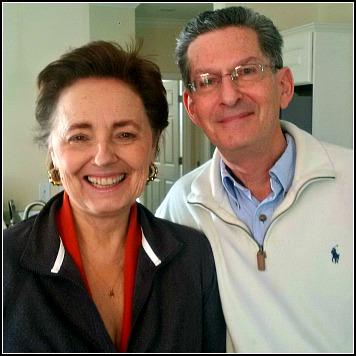
37 Twin Oaks
Moved in January 2014
Originally from: Jules: Brooklyn and Baldwin, NY; Faith: Barnstable, MA
How They Met: We met in Golden Gate Park in San Francisco. Jules was showing art work done through art therapy and Faith came to see the show.
Previous Residences: West Virginia, New Orleans, Texarkana, Texas. They have a home in New Orleans and plan to live both there and on the Cape.
What Kind of Work Did You Do: Jules: Psychologist, college professor, writer; Faith: Business and retail management and college librarian
Why Southport: Faith: The Cape has always been home for me; I was ready to come back home. Jules: We heard about Southport, looked at the website and had an outside realtor look at the models for us and bought sight unseen.
Like Best about Southport: Sense of community and active adult lifestyle
Like Least: More street lights needed and don't find all the plow sticks very attractive.
Want to Get Involved with: Jules: Woodworking, art classes, men's coffee, biking, tennis; Faith: Exercise, book club, yoga, needle arts, tennis
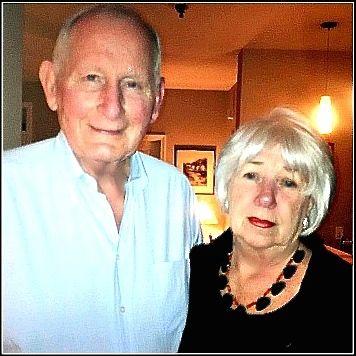 Art & Kathy Grob
72 Grey Hawk Drive
Moved in June 2015
Originally from: Art: Chicago, north side; Kathy: Chicago, south side
How They Met: Kathy's mother was a switchboard operator where Art worked. She told him, "You have to meet my daughter."
Previous Residences: Palos Park, IL; Rochester, NY and Fairfield, CT
What Kind of Work Did You Do: Art: Sales in the food industry, still working; Kathy: Homemaker
Why Southport: We were flooded in Fairfield from Hurricane Sandy, ready to move on. We always loved the Cape and find people here very friendly. The Cape has a small town feeling similar to Fairfield.
Like Best about Southport: Everyone is friendly and helpful.
Like Least: Would love to see a restaurant right in Southport.
Want to Get Involved with: Kathy: Scholarship Committee, mah jong, bridge; Art: Bocce, working out, men's coffee, golf. Art helped out with the Mashpee High School football team, 2015 MA State Champions.
|
|
The Doomsday File
by Bob Keeling
|
They say pick a job that you love and you'll never work a day in your life. Working in the financial services industry over the past 24 years has been pretty close to fulfilling that old adage for me. Unfortunately not everything can always be wine and roses. The most disappointing aspect of my line of work has been watching families torn apart as they fight over the estate of a loved one -- especially since this usually can be avoided. By doing proper estate planning you can clearly delineate who gets what from your estate after you are gone, but this doesn't always eliminate hard feelings. Siblings want to know why he is the trustee and not her; kids want to know why stepmom gets the money instead of them.
There are two ways to avoid this. The first is to sit your heirs down and talk to them about your estate. Who are the executors, who are the trustees, who has authority under your health care proxy or power of attorney -- and most importantly, why? "We named Sarah as health care proxy because she lives closest, but we named Jane as trustee because she is the oldest."
These meetings can take place in the office of your attorney or financial advisor if you want a third party to help you with the conversation. If things don't go well and you realize that feelings will still be hurt, you then have the opportunity to name a disinterested third party, like an attorney or professional trustee to handle these issues -- or to say 'the heck with these guys' and give it all to charity!
Some people don't want to reveal that much to their heirs up front, and that's where the 'doomsday file' comes in. The doomsday file is a folder of some very distinctive color in your file cabinet or desk -- say neon green, or hunter's orange. In that file you place the name and contact information of your estate attorney, financial advisor, accountant and anybody else who is critical for your heirs to contact; e.g., tenants of any rental properties you own, the general manager of your condo complex in Florida, the funeral home where you've prepaid for your services, etc. All you have to tell your heirs is: "When it's time, get the bright pink folder out of the desk in the living room, everything you need is in there."
Even if you have the sit-down conversation, having a doomsday file still makes sense, but if you don't have that meeting you can add a letter or letters to the file explaining why you named who to their various roles. It goes a long way toward preventing hard feelings to be able to say, "That's the way Mom wanted it."
NOTE: Bob Keeling is president of Keeling Financial Strategies, Inc., Mashpee.
Securities and advisory services offered through Commonwealth Financial Network, member FINRA/SIPC, a registered investment adviser.
|
|
Out & About at Southport
|
| |
The Southport Sound presented a holiday concert for the residents of Bridges on December 15.
Judy Bergh directed, Sandy DiMartino played the piano, Al Towle impersonated Santa Claus
and Bonnie Towle took the picture.
|
|
| |
Strengthening & Stretching at Southport. Photo: Andy Jablon
|
|
|
|
Contributors to the
January 2016 Edition of
Southport Village Voices
|

Lydia Biersteker
grew up in Somerville, MA. She met her husband Dale on the beach at Falmouth Heights in 1969, while he was stationed at Fort Devens. After Dale retired in 2005 from his executive position with the USPS, they moved to Vero Beach, FL but decided that they preferred New England. They moved to Southport in 2011. Dale plays golf, and Lydia likes gardening, walking, writing poetry and short prose, exploring genealogy, and lunching with friends. Together, they enjoy dining, exploring wineries and brew pubs, walking the trails of Cape Cod, traveling and playing with their grandkids, who live on the North Shore.
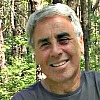 Andy Jablon Andy Jablon owns a television production company in Watertown, providing crews to shoot stories in New England for the major TV networks. As producer, he interviews all sorts of interesting people on a regular basis. His wife TracyTebbutt works at a cancer pharmaceutical company in Cambridge. They split their time between Southport and Boston, depending on work schedules. Both are enthusiastic cyclists, riding their bikes along the Charles River to work in all kinds of weather. At Southport, they relax by walking, biking, playing tennis and soaking in the hot tub.
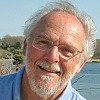 David Kapp David Kappwith his wife Billie, moved from Connecticut to Southport in 2009. David retired from a career as a university library administrator, after working in the libraries at Brandeis, Harvard and the University of Connecticut. He was a building consultant for the planning of a number of major university libraries and was, for many years, the editor of Connecticut Libraries. Billie enjoyed a career as an educator and social sciences consultant. The Kapps are frequent visitors to Hawaii where their daughter, son, grandson and many other family members live.
 Bob Keeling Bob Keeling
grew up in Sharon, MA , moved to East Falmouth in 1990, and to Southport in 2015. He is a graduate of the New England Institute of Applied Arts and Sciences in Boston and the National Aviation Academy in St. Petersburg, FL. Bob is a former US Marine and corporate pilot, a flight instructor for airplanes and instruments, and a ground instructor. He's been a financial planner with Keeling Financial Strategies in Mashpee for 24 years. Bob volunteers with Hospice and is a volunteer Reiki practitioner with people and animals. He's the former director and chairman of the board of Hope Health Care in Hyannis. Bob is single; his daughter Beth lives in Walpole, MA, and his son Bryan lives in Kansas. He has three grandchildren, loves dogs and has traveled extensively. On his first trip to Bermuda, he piloted a small twin engine plane from Nantucket to Bermuda and back.
 Tom Kelleher Tom Kelleher
grew up in Lowell, MA and stayed in that area after marrying Kathryn, his "college sweetheart" and wife of 43 years. After raising a family of five children and somehow paying for five private college educations, Tom and Kathryn retired to Southport in August 2014. Tom pursued a career in public and private education that spanned 42 years. He was a teacher and administrator at Dracut High School and later principal at Nashua Catholic Regional Junior High in Nashua, NH. Upon retirement and prior to moving to Southport, Tom took on a "fun" job as a part-time museum teacher and history tour guide at Lowell National Historical Park. In addition to history, Tom's other passion is singing and playing guitar in various "open mic" and song circle venues in the Falmouth/Sandwich area. Tom also performs for patients at the Tradewinds Adult Day Care Center in Sandwich.
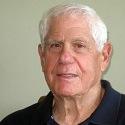 Bob Mendes Bob Mendes
began his career as an advertising copywriter at Doyle Dane Bernbach in NYC before becoming senior vice president of marketing for a west coast department store chain. He left that position to start Pacific Sports, a sports and general marketing agency. There he developed "The Reading Team," a children's literacy program sponsored by the NFL and the American Library Association, using NFL players as literacy role models. Bob is the author of "A Twentieth Century Odyssey, the Bob Mathias Story." After retiring, he served as executive director of the Glendora, CA Chamber of Commerce. When grandson Adam was born, Bob and Bette moved to Cape Cod. He's had a number of part-time jobs, has written two more books, and volunteers. Bette serves on the Board of Governors and volunteers at the Falmouth Jewish Congregation. Their son Steve, a pediatrician, lives in Marion with his wife Sarah and their children; a second son, Jeff, practices law in Indianapolis.
 Ray Schumack Ray Schumack
has held positions as a magazine editor, publicity director and an account executive for a Madison Avenue advertising and public relations agency. He served for 15 years as chief communications officer for a Fortune 500 company, responsible for all corporate communications and product promotion literature. His business articles have appeared in the Wall Street Journal, the New York Times, Fortune magazine and elsewhere. He established his own public relations firm and continues to serve several clients in retirement. His recent memoir, News Releases from the Korean War, recounts his experiences as a war correspondent.
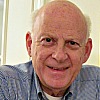 Roy Smith Roy Smith
grew up in East and West Bridgewater, MA. He served as a corpsman in the US Coast Guard on the weather cutter USCGC Castle Rock and the icebreaker USCGC Eastwind, on voyages from the Arctic to the Antarctic. In his thirty-year career at the Woods Hole Oceanographic Institution he was initially a sea-going chemistry tech and later an administrator in the Geology and Geophysics Department. After retiring from WHOI, he was general manager of McLane Research Laboratories in Falmouth. Roy met his wife Cynthia at WHOI, where she worked summers while on teaching break. They moved to Southport two years ago and consider the choice one of their best. Since retirement both have volunteered at the Falmouth Service Center. Roy has charitable woodworking projects underway at all times and Cynthia is involved with various charities on the Upper Cape. They have two sons, Jason, an engineer at WHOI, and Aaron, a sculptor, and two beautiful granddaughters.
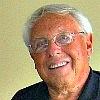 Arthur Wagman Arthur Wagman
and his wife Bobby moved to Southport in 2002. After graduating from Boston University, Arthur was commissioned into the US Air Force. He and Bobby were stationed in France, where their first child was born. Leaving the Air Force as a Captain, he returned to BU, earned his doctorate and began a lifelong career in education. Arthur was assistant superintendent for finance for Wayland, MA Public School, leaving to become the bursar at the Massachusetts Institute of Technology. After leaving MIT he returned to public education and served as superintendent of Dedham, MA Public Schools. Arthur started and is president of Educational Resources Management, a consulting company working with school boards and architects to develop educational specifications for new schools. He and Bobby have three children and five grandchildren.
Special Thanks To
Ed Larkin for his interview and pictures,
Jules & Faith Weiss and Art & Kathy Grob for their interviews,
Rosanne Francesconi for her painting,
Bonnie Towle & Andy Jablon for their photographs
and to my proofreader Billie Kapp
|
|
|
|
|
|
|
|